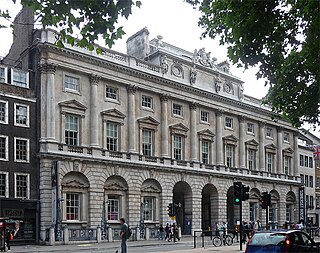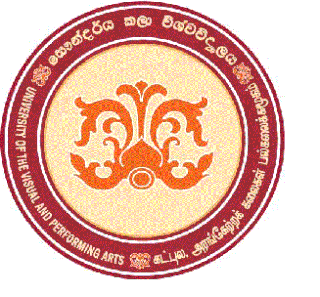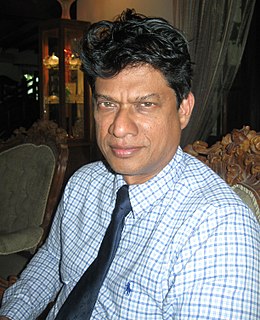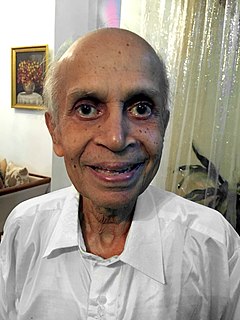Jagath Weerasinghe (Sinhalese: ජගත් වීරසිංහ) | |
|---|---|
| Born | 1954 |
| Nationality | Sri Lankan |
Jagath Weerasinghe (1954) is a Sri Lankan contemporary artist and archeologist.
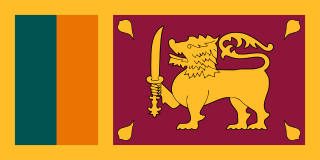
Sri Lanka, officially the Democratic Socialist Republic of Sri Lanka, is an island country in South Asia, located in the Indian Ocean to the southwest of the Bay of Bengal and to the southeast of the Arabian Sea. The island is geographically separated from the Indian subcontinent by the Gulf of Mannar and the Palk Strait. The legislative capital, Sri Jayawardenepura Kotte, is a suburb of the commercial capital and largest city, Colombo.
Weerasinghe has been a significant driving force in the development of Sri Lankan art since the early 1990s. He is Director of the Postgraduate Institute of Archaeology at the University of Kelaniya. [1] [2]

The University of Kelaniya is a state university of Sri Lanka. Just outside the municipal limits of Colombo, in the city of Kelaniya, the university has two major campuses, seven locations, six faculties and four institutions.
He obtained a Bachelor of Fine Arts with Honours in Painting at the Institute of Aesthetic Studies, University of Kelaniya, Sri Lanka in 1981. [3] In 1985 he received a Conservation of Wall Paintings, International Centre for the Study of the Preservation and Restoration of Cultural Property (ICCROM) in Rome, which was followed in 1988 by a Conservation of Rock Art from the Getty Conservation Institute in Los Angeles.[ citation needed ]
A Bachelor of Fine Arts is the standard undergraduate degree for students in the United States and Canada seeking a professional education in the visual or performing arts.

The International Centre for the Study of the Preservation and Restoration of Cultural Property (ICCROM) is an intergovernmental organization dedicated to the preservation of cultural heritage worldwide through training, information, research, cooperation and advocacy programmes. It aims to enhance the field of conservation-restoration and raise awareness to the importance and fragility of cultural heritage.
The Getty Conservation Institute (GCI), located in Los Angeles, California, is a program of the J. Paul Getty Trust. It is headquartered at the Getty Center but also has facilities at the Getty Villa, and commenced operation in 1985. The GCI is a private international research institution dedicated to advancing conservation practice through the creation and delivery of knowledge. It "serves the conservation community through scientific research, education and training, model field projects, and the dissemination of the results of both its own work and the work of others in the field" and "adheres to the principles that guide the work of the Getty Trust: service, philanthropy, teaching, and access." GCI has activities in both art conservation and architectural conservation.
In 1991 Weerasinghe obtained a Master of Fine Arts in Painting at the American University, Washington, D.C. [3]
A Master of Fine Arts is a creative degree in fine arts, including visual arts, creative writing, graphic design, photography, filmmaking, dance, theatre, other performing arts and in some cases, theatre management or arts administration. It is a graduate degree that typically requires two to three years of postgraduate study after a bachelor's degree, though the term of study varies by country or university. The MFA is a terminal degree. Coursework is primarily of an applied or performing nature with the program often culminating in a major work or performance. The first university to admit a student to the degree of Master of Fine Arts was the University of Iowa in 1940.

The American University is a private research university in Washington, D.C. Its main campus spans 90 acres at the former site of Fort Gaines on Ward Circle, in the Spring Valley neighborhood in the northwest of the District. AU was chartered by an Act of Congress in 1893 at the urging of Methodist bishop John Fletcher Hurst, who sought to create an institution that would promote public service, internationalism, and pragmatic idealism. AU broke ground in 1902, opened in 1914, and admitted its first undergraduates in 1925. Although affiliated with the United Methodist Church, religious affiliation is not a criterion for admission.
Weerasinghe coined the phrase ‘90s Art Trend’, recognising at the time the need for a cohesive framework to describe the activity of his peer group. [1] This adopting of a phrase as framework by Weerasinghe acted as a catalyst for theoretical inquiry into the politically conscious contemporary art praxis of the 1990s in Sri Lanka.
He was commissioned by the Sri Lankan government to design the monument ‘Shrine for the Innocent’ as a remembrance for the innocent victims of the violence that the southern part of the country experienced in the late 1980s and early 1990s with the work completed in 1999. [4]
He co-founded the Theertha International Artists Collective in 2000, and served as its Chairman till 2017. Theertha continues to foster new artists and initiatives. [1] [5] He describes current Sri Lankan artists as living in an era of ‘para-modernism’.
Weerasinghe's works have been exhibited in the United States, United Kingdom, Australia, India, Netherlands, Germany and Japan. [6]
